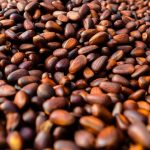Measuring riboflavin and folic acid simultaneously in beverages can be difficult to achieve but research using synchronous fluorescence has recently been successful (Wang et al., 2011). The method of synchronous fluorescence is regularly used to monitor pharmaceutical components, proteins and amino-acids and can be used to discriminate between actives. Many of the previous methods such as high-performance liquid chromatography (HPLC) (Russell et al., 1998), reversed phase liquid chromatography (Viñas et al., 2004) and capillary electrophoresis have the disadvantage of using unpleasant organic solvents, being time consuming and requiring work-up prior to use. The new method is simpler using H2O2 and Cu(II) to convert folic acid to a fluorescent agent, pterine-6-carboxylic acid which is then measured with riboflavin in a spectrophotometer. Folic acid is measured in the range of 100 to 250 ug/L and riboflavin from 1 to 250 ug/L . The research explored the chemistry behind the methodology including factors affecting the reaction such as pH, metal ions and other vitamins, and was found to have little effect on the two vitamins’ measurement.
Russell, L.F., Brooks, L., McRae, K.B. (1998) Development of a robotic-HPLC determination of riboflavin vitamers in food. Food Chem., 63(1) pp. 125-131
Vinas, P.; Balsalobre, N.; Lopez-Erroz, C.; Hernandez-Cordoba, M. (2004) Liquid chromatographic analysis of riboflavin vitamers in foods using fluorescence detection. J. Agric. Food Chem.52(7), pp. 1789-1794
Wang, Y., Zhu, P-H., Tian, T., Tang, J., Wang, L., Hu, X-Y. (2011) Synchronous Fluorescence as a Rapid Method for the Simultaneous Determination of Folic Acid and Riboflavin in Nutritional Beverages. J. Agr. Food Chem., DOI: 10.1021/jf202536m


Leave a Reply